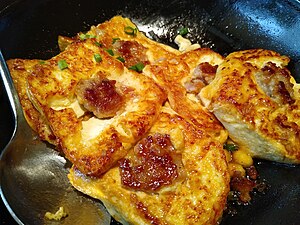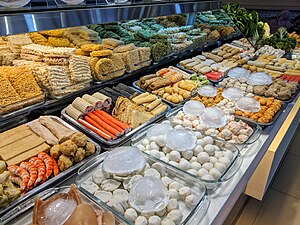Yong tau foo
-
 Media: Yong tau foo
Media: Yong tau foo
| Yong tau foo | |||||||||||||||||||||
|---|---|---|---|---|---|---|---|---|---|---|---|---|---|---|---|---|---|---|---|---|---|
| Chinese name | |||||||||||||||||||||
| Traditional Chinese | 釀豆腐 | ||||||||||||||||||||
| Simplified Chinese | 酿豆腐 | ||||||||||||||||||||
| Literal meaning | "stuffed bean curd" | ||||||||||||||||||||
| |||||||||||||||||||||
| Vietnamese name | |||||||||||||||||||||
| Vietnamese | khổ qua cà ớt[1] | ||||||||||||||||||||
| Literal meaning | "bitter melon (and) chili pepper" | ||||||||||||||||||||
| Thai name | |||||||||||||||||||||
| Thai | ก๋วยเตี๋ยวแคะ | ||||||||||||||||||||
Yong tau foo (simplified Chinese: 酿豆腐; traditional Chinese: 釀豆腐; also spelled yong tao foo, yong tau fu, yong tau hu or yong tofu; ก๋วยเตี๋ยวแคะ in Thailand) is a Hakka Chinese dish consisting primarily of tofu filled with ground meat mixture or fish paste. Variations on this dish feature - instead of tofu - vegetables and mushrooms stuffed with ground meat or fish paste. Yong tau foo is eaten in numerous ways, either dry with a sauce or served as a soup dish.
It is commonly found in parts of China, Indonesia, Malaysia, Singapore, Thailand, Vietnam,[1] and in cities where there are large Hakka populations.[2]
History
Long ago, the Hakkas started migrating Southwards in order to flee the war in Northern China and through a series of migrations, finally settled Southern China. Because they couldn't get hold of wheat flour to make dumpling skins during the festivals, they started using tofu instead. The word “Nyong” in Hakka describes the action of filling the tofu with the stuffing and hence “Yong Tau Foo” was born
Variations
Fried
Traditional Hakka versions of yong tau foo consists of tofu cubes stuffed and heaped with minced meat (usually lamb or pork) and herbs, then fried until golden brown, or sometimes braised.[citation needed] Variations include usage of various condiments, including eggplants, shiitake mushrooms, and bitter melon stuffed with the same meat paste. Traditionally, yong tau foo is served in a clear yellow bean stew along with the bitter melon and shiitake variants.[3]
Soup
Particularly in the Southeast Asian Hakka diaspora, the term "yong tau foo" is used to describe a soup dish that substitutes minced meat with fish paste. The base of the dish is various forms of tofu stuffed with fish paste, but it is now common to stuff vegetables like bitter melon, okra, chilis with fish paste as well, and the soup can include other ingredients like fish balls, crab sticks, cuttlefish, sausages, etc. The foods are then sliced into bite-size pieces, cooked briefly in boiling broth and then served either in the broth as soup or with the broth in a separate bowl ("dry"). The dish is eaten with chopsticks and a soup spoon and can be eaten by itself or served with a bowl of steamed rice, noodles or rice vermicelli. Another variation of this dish would be to serve it with laksa gravy or curry sauce. Essential accompaniments are a spicy, vinegary chili sauce, originally made with red fermented bean curd and distantly similar in taste to Sriracha sauce, and a distinctive brown sweet bean sauce or hoisin sauce for dipping.[2]
Regional variations
In Malaysia, particularly the Klang Valley, yong tau foo is often associated with the city of Ampang, Selangor, just outside the eastern end of Kuala Lumpur.
Thai yentafo, while otherwise similar, has a distinct pink colored-broth due to the use of fermented bean paste, which may be supplemented by blood or food colouring.[4]
In Vietnam, particularly in southern Vietnam, khổ qua cà ớt consists of fish paste (known as chả cá) that is stuffed into either bitter melon, large chili peppers, fried tofu, eggplants, or tomatoes before being fried. The dish can be eaten as is, dipped in sauce, or in a bowl with broth.[1]
Gallery
-
 Traditional braised yong tau foo
Traditional braised yong tau foo -
 Hakka yong tau foo served with brown sweet bean sauce
Hakka yong tau foo served with brown sweet bean sauce -
 A "buffet" selection of ingredients for yong tau foo in Malaysia
A "buffet" selection of ingredients for yong tau foo in Malaysia -
 A bowl of Thai yen tafo
A bowl of Thai yen tafo
See also
References
- ^ a b c Phạm, Khôi (December 21, 2020). "Hẻm Gems: Saigon's Hakka Culture Lives in D5's Khổ Qua Cà Ớt". Saigoneer.
- ^ a b ภูผาฟ้าทะเล (2012-09-19). "ย้งเที้ยวฟู เย็นตาโฟ". Pantip.com (in Thai).
- ^ gabriel (2004-09-21). "น้ำสีแดงๆที่ใช้ใส่เย็นตาโฟนี่มันทำมาจากอะไรครับ แล้วมีขายที่ไหนครับ". Pantip.com (in Thai).
- ^ "The distinctive pink colour of yentafo makes it stand out from the crowd". 23 November 2016.
| Part of a series on |
| Chinese cuisine |
|---|
 |
|
| Ingredients and types of food |
|
|

























